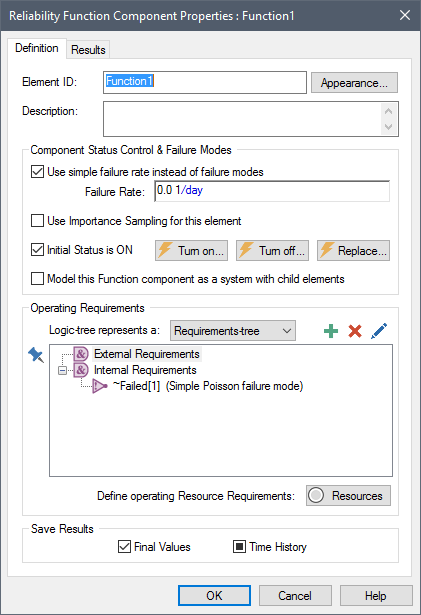Function elements are used to represent services that are carried out over a period of time.
The default icon for the Function element looks like this:

The Function element has several outputs, but the key output is its Status (the primary output For an element with multiple outputs, the output that has the same name as the element. of the element). The Status is an integer that takes on one of a number of values. Typically, we are most interested in whether the component is operating (Status = 0). In order for a Function element to be operating, it must be turned "On". It will cease operating if it is 1) turned "Off"; 2) it fails for some reason; 3) it is being maintained; 4) its specified operating requirements are not met; or 5) it is part of a subsystem and its parent stops operating. Each of these states is indicated by a unique value for the Status.
The properties dialog for the Function element looks like this:

The key parts of the dialog are summarized below.
The "Component Status Control & Failure Modes" portion of the dialog is where the primary properties of the component being modeled are specified, including simple failure rates, the initial status of the component, and triggers for turning the component on and off and for replacing it:
Use simple failure rate instead of failure modes. When this checkbox is selected, the Failure Rate specified in the text box below is used as the only failure mode (this assumes an exponential/Poisson failure). When the checkbox is cleared, a Failure Modes tab will appear, and you can use GoldSim's advanced failure modes instead of a failure rate.
Use Importance Sampling An algorithm that biases sampling of probability distributions in order to better resolve the tails of the distributions. for this element: Checking this option enables a modified sampling algorithm that allows GoldSim to better represent low-probability (i.e., rare) failure events without requiring a large number of realizations. Note, however, that this advanced feature must be used with caution.
Initial Status is On. If this box is checked, the component is assumed to be "On" at the beginning of the simulation.
Turn On, Turn Off and Replace Triggers. These buttons provide access to triggers that allow you to turn the component On or Off or replace it. Replacing the component "resets the clock" for all failure modes.
Model this Function component as a system with Child Elements. This checkbox allows you to turn the element into a Container An element that acts like a "box" or a "folder" into which other elements can be placed. It can be used to create hierarchical models. and place other GoldSim elements inside this element. Note that when you do so, a new tab will appear (Graphics). This tab is common to all Containers in GoldSim.
The "Operating Requirements" portion of the dialog allows you to define (in the form of a Requirements-tree A logic tree in a Reliability Module element that that must evaluate to True in order for the component to operate. or Fault-tree A logic tree in a Reliability Module element that that must evaluate to False in order for the component to operate.) the conditions necessary for the component to operate. You can also specify Resource Something that has a limited supply (e.g., spare parts, fuel, skilled personnel, money) and is required in order for elements of the modeled system to carry out certain actions. Requirements necessary for the component to operate.
All Reliability elements have a Results tab. After a simulation has been run, the Results Tab can be used to access result statistics and the unique causality trees and root causes which resulted in failure of the element.
Learn more
- Common Reliability Element Outputs
- Failure Rates and Failure Modes
- Using Importance Sampling for Reliability Elements
- Turning Components On and Off in the Reliability Module
- Modeling a Reliability Element as a System with Child Elements
- Defining Operating Requirements for Reliability Elements Using Logic Trees
- Modeling Resources in the Reliability Module
- Displaying Reliability Results
- Advanced Features of the Action Element
- Defining Failure Modes
- Defining Operating Requirements for Reliability Elements Using Logic Trees
- Inputs, Outputs and Features Specific to the Action Element
- Modeling Maintenance in the Reliability Module
- Modeling Resources in the Reliability Module
- Overview of the Action Element
- Overview of the Function Element
- The Common Inputs and Features of the Reliability Elements
- The Common Outputs and Locally Available Properties of the Reliability Elements
- The Difference Between the Function and the Action Elements
- Turning Components On and Off in the Reliability Module